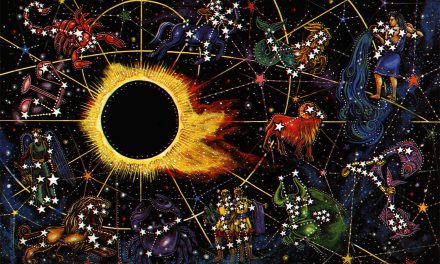Pandit Samanta Chandra Sekhar Harichandan Mohapatra, locally known as “Pathani Samanta”, was the illustrious author of Siddhanta Darpan – a systematic record of his life-long relentless work composed in beautiful metrical Sanskrit verses . Siddhanta Darpan is an astronomical treatise in elegant Sanskrit verses, developed and improved upon the Surya-Siddhanta and the Siddhanta- Siromani of the past. This magnum opus of Chandra Sekhar, the last and best book is worthy of its name as a real mirror of India’s astronomical knowledge.
A Hindu orthodox by nature, Chandra Sekhar, with his traditional background alone studied the subject of astronomy, observed the movements of planets through naked eyes and was able to reach the approximate reality as founded by scientists with the aid of modern equipments. He was an outstanding mathematician of high order and engaged himself in the field of mathematical calculations known as Astronomy.
In Siddhanta Darpan, poetry and mathematics are in tune with each other, and this stands as a specimen of his genius. By sheer efforts and perseverance, this last and foremost orthodox Hindu siddhanta writer could rise above his environment. He left an indelible stamp of his genius on the history of Indian astronomy. His ability in the use of manayantra (measuring instrument), “Golyantra” (spherical instrument) and surya-ghadi (sundial to measure the time) proved him to be a good architect with engineering skill.
He had also interest in the preparation of fire works with knowledge to launch the same to a particular height. India is a nation of ancient culture and tradition. It reached the zenith in all spheres at one time when most of the so-called advanced nations of to-day were not discovered. Indian astronomy is nearly as old as the Vedas. As a science, it rose to its peak in the days of Aryabhatta in the 5th century A.D. Indian astronomy is a mere curiosity to the scholars of the West. They know very little about our traditional mathematical astronomy because it does not come under the mainstream of astronomy which originated in Babylonia and evolved through the Greeks and Europeans. Hence neither are the scholars of the West fair enough to assess the merit of our system, nor are we sincere to project ourselves sufficiently in order to establish our wit and wisdom before the so-called advanced world.
Chandra Sekhar recorded all of his findings in Siddhanta Darpan, a small book with about 2500 verses(24 chapters) in Sanskrit language entirely written on palm-leaves. Will Durrant was amazed to find this great Hindu scholar writing treatises on mathematics even in verses. This invaluable contribution of Chandra Sekher to the astronomical science, Siddhanta Darpan was written on April 12, 1869 and completed in all respect by November 12, 1892. Out of its 2,500 verses (slokas), 2,184 are his own. The composition and structure of the verses indicate his extraordinary genius and deep knowledge in Sanskrit. The verses are highly ornamental and orderly. They flow like a running stream unchecked, un-controlled, un-restricted and unbridled.
The contents of Siddhanta Darpan look amazing and unimaginable as the achievement of a single mind. Chandra Sekhar observed, verified and corrected all that was known to the Hindu astronomers for thousand of years. Even on many occasions he has gone beyond them to discover new phenomena and formulations, and came out with predictions that will remain valid for at least the next ten thousand years. In the field of observational astronomy, very often he has given new methods of calculation. At the end of his treatises he has furnished the calculations of an almanac, which has been named the Kautuka Panjee.
Among those who applied their brain and mind for the improvement as well as development of Panjika, the name of Chandra Sekhar figures in a very eminent position. A glorious personality by virtue of his high academic attainments, scholarly approach to the problems and moral effulgence, Chandra Sekhar no doubt shines best in the history of Panjika-Samskara”. In 1876, the almanac computed according to Siddhanta Darpan found recognition in the temple of Sri Jagannath, and religious rites there are calculated/determined as per the latest Siddhanta of Chandra Sekhar.
Nearly one thousand years before the birth of Chandra Sekhar, no astronomer of repute had made any reformative study in the field of astronomical science. In order to know the exact longitude (grahasphuta of the planets) he took the help of Surya Siddhanta as his base book and innovated new methods in each chapter of Siddhanta Darpan.
As the moon changes its position more frequently than any other planet, it is very difficult to ascertain the exact longitude of moon. Hence, Chandra Sekhar innovated three principles, i.e. Tungatanra, Pakshika and Digamsa to know the exact longitude of moon. These three formulas expounded by him are very correct and they hold good in every respect. Likewise he had devised many new formulas for ascertaining the exact longitude of all the planets. His formulas regarding the solar and lunar eclipse are still invaluable objects in the astronomical treasury.
Completely unaware of the scientific and technological developments in the West, Chandra Sekhar had employed the traditional methods for astronomical measurements. He was well known in India and beyond for his accurate astronomical calculations, new theories about the planets and their movements, which were based on observations made by his naked eyes or with primitive instruments designed by himself. So he is rightly called the second Bhaskara in India. Chandra Sekhar seems to be the last link in the long order of great Hindu astronomers like Aryabhatta, Varahamihira, Brahma Gupta and Bhaskara, whose genius blazed from places spread all over India, scaling a time span of nearly 1,500 years, with available systematic record from 5th century A.D. to the turn of the last century. This continuous stream of genius appeared to have broken after Bhaskara for about seven hundred years, and one sees the burst of the last glow in Chandra Sekhar.
The long traditional culture of Jyotisha in Orissa for so many centuries was epitomized in Chandra Sekhar, who was honoured with the title of “Mahamahopadhyaya” by the British government in 1893 for his monumental work on Hindu astronomy, Siddhanta Darpan. He corrected the discrepancies in the astronomical calculations found in the annually prepared Almanac of Orissa.
Astronomy is a science in which observations go simultaneously with the calculations. Besides a thorough knowledge of motion of the stellar objects, it requires sufficient computational skill to tackle the vast multitude of big numbers. Chandra Sekhar was extraordinary in this respect, demonstrating a computational fit by providing tables with cores of data which pose a challenge even in this computerized age.
Chandra Sekhar had expressed his deep gratitude to all his predecessors in general and Bhaskaracharya in particular. He improved upon their calculations after careful observation of the planetary positions. Like any other original research work, his contributions are purely of intellectual interest in the field of mathematical astronomy.
The present Oriya Almanacs are being prepared as per the rules of Siddhanta Darpan and they have stood the test of time in successfully predicting the eventful occasions like eclipses. He had broken the icewhich blocked the path of progress in Indian astronomy for about a thousand years and mirrored the Siddhantas in modern perspectives, paving the way for future development. Our researchers today boast of degrees conferred on the basis of works which can hardly be compared with the originality and innovations that Chandra Sekhar has exhibited in a single chapter of his Siddhanta Darpan and its stupendous tables, called saranis. His contribution to the field of Hindu astronomy is little known and assessed due to the non-availability of a lucid commentary explaining the intricacies of astronomical calculations involved in understanding the Sanskrit verses composed in elegant pendantic style.
Pathani Samanta, alias Chandra Sekhar, was born in Khandapada, an ex-state of Orissa, in the un-divided Puri district of Orissa, on 11th January 1836 (the 8th lunar day of black fortnight in Pausa month of Saka era 1757). His final departure from this mortal world was on 11th June 1904. As per his own prediction, he came all the way to Sri Jagannath Temple at Puri to breathe his last.













Do we have Siddhanta Darpan in any publication..Please